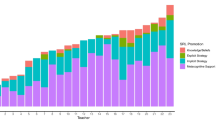Abstract
The research reported in this paper explores teachers’ conception of what mathematics lesson structure is like by analyzing the lesson plans they wrote. Japanese in-service and pre-service teachers (n = 246) were asked to produce a lesson plan for teaching the formula for finding the area of a parallelogram. Organizations of planned lessons were analyzed in terms of the form and content of steps/phases descriptions of them. Also, the multiplicity was analyzed of anticipated students’ responses to the problem posed in the plans. The analysis revealed both similarities and differences between lesson plans produced by the two groups of teachers. In particular, it was found that in-service teachers tended to retain the description of the problem to be posed and the anticipation of student responses in their lesson plans, while they abandoned other elements that they were trained to write when they were pre-service teachers. The results suggest that these two elements constitute the “core” of Japanese teachers’ conception of lesson structure. Origins of these core elements are discussed with a focus on the role of lesson plans as vehicles for examining and improving lessons in Lesson Study.




Similar content being viewed by others
References
Ball, D. L., & Bass, H. (2000). Interweaving content and pedagogy in teaching and learning to teach: Knowing and using mathematics. In J. Boaler (Ed.), Multiple perspective on mathematics teaching and learning. Westport: Ablex Publishing.
Becker, J. P., Silver, E. A., Kantowski, M. G., Travers, K. J., & Wilson, J. W. (1990). Some observations of mathematics teaching in Japanese elementary and junior high schools. The Arithmetic Teacher, 38, 12–21.
Clark, C. M., & Peterson, P. L. (1986). Teachers’ thought processes. In M. C. Wittrock (Ed.), Handbook of research on teaching (3rd ed.). New York: Macmillan.
Clarke, D., Mesiti, C., Jablonka, E., & Shimizu, Y. (2006). Addressing the challenge of legitimate international comparisons: Lesson structure in Germany, Japan and the USA. In D. Clarke, J. Emanuelsson, E. Jablonka & I. Ah Chee Mok (Eds.), Making connections: Comparing mathematics classrooms around the world. Rotterdam: Sense Publishers.
Fernandez, C., & Yoshida, M. (2004). Lesson study: A Japanese approach to improving mathematics teaching and learning. Mahwah: Lawrence Erlbaum Associates.
Hiebert, J. (2003). Signposts for teaching mathematics through problem solving. In F. K. Lester (Ed.), Teaching mathematics through problem solving: Prekindergarten-grade 6, National Council of Teachers of Mathematics. Reston: The Council.
Hiebert, J., Gallimore, R., Garnier, H., Givvin, K. B., Hollingsworth, H., Jacobs, J., et al. (2003). Teaching mathematics in seven countries: Results from the TIMSS 1999 Video Study. U.S. Department of Education. Washington, DC: National Center for Education Statistics.
Jacobs, J., & Morita, E. (2002). Japanese and American teachers’ evaluations of videotaped mathematics lessons. Journal for Research in Mathematics Education, 33, 154–175. doi:10.2307/749723.
Lester, F. K. & Charles, R. I. (Eds.). (2003). Teaching mathematics through problem solving: Prekindergarten-grade 6, National Council of Teachers of Mathematics. Reston: The Council.
Miwa, T. (1992). School mathematics in Japan and the U.S.: Focusing on recent trends in elementary and lower secondary schools. In I. Wirszup (Ed.), Developments in school mathematics education around the world (Vol. 3). Reston: National Council of Teachers of Mathematics.
Shank, R., & Abelson, R. (1977). Scripts, plans, goals, and understanding. Hillsdale: Lawrence Erlbaum Associates.
Shimizu, Y. (1999a). Aspects of mathematics teacher education in Japan: Focusing on teachers’ roles. Journal of Mathematics Teacher Education, 2(1), 107–116. doi:10.1023/A:1009960710624.
Shimizu, Y. (1999b). Studying sample lessons rather than one excellent lesson: A Japanese perspective on the TIMSS Videotape Classroom Study. Zentralblatt für Didactik der Mathematik, 6, 191–195.
Shimizu, Y. (2006). How do you conclude today’s lesson? The form and functions of “Matome” in mathematics lessons. In D. Clarke, J. Emanuelsson, E. Jablonka & I. Ah Chee Mok (Eds.), Making connections: comparing mathematics classrooms around the world. Rotterdam: Sense Publishers.
Stigler, J. W., Fernandez, C., & Yoshida, M. (1996). Cultures of mathematics instruction in Japanese and American elementary classrooms. In T. P. Rohlen & G. K. Letendre (Eds.), Teaching and learning in Japan. Cambridge: Cambridge University Press.
Stigler, J. W., Gonzales, P., Kawanaka, T., Knoll, S., & Serrano, A. (1999). The TIMSS Videotape Classroom Study: Methods and findings from an exploratory research project on eighth-grade mathematics instruction in Germany, Japan, and the United States. Washington, DC: U.S. Government Printing Office.
Stigler, J. W., & Hiebert, J. (1999). The teaching gap. New York: Free Press.
Stigler, J. W., & Perry, M. (1988). Cross cultural studies of mathematics teaching and learning: Recent findings and new directions. In D. A. Grouws & T. J. Cooney (Eds.), Perspectives on research on effective mathematics teaching. Mahwah: Lawrence Erlbaum Associates.
Acknowledgments
The author would like to express his thanks to Akira Kugaya and Akiko Seki for their works on coding reported in this paper. He is also grateful for the helpful comments made by anonymous reviewers.
Author information
Authors and Affiliations
Corresponding author
Appendix: A sample lesson plan
Appendix: A sample lesson plan

Rights and permissions
About this article
Cite this article
Shimizu, Y. Exploring Japanese teachers’ conception of mathematics lesson structure: similarities and differences between pre-service and in-service teachers’ lesson plans. ZDM Mathematics Education 40, 941–950 (2008). https://doi.org/10.1007/s11858-008-0152-6
Accepted:
Published:
Issue Date:
DOI: https://doi.org/10.1007/s11858-008-0152-6




